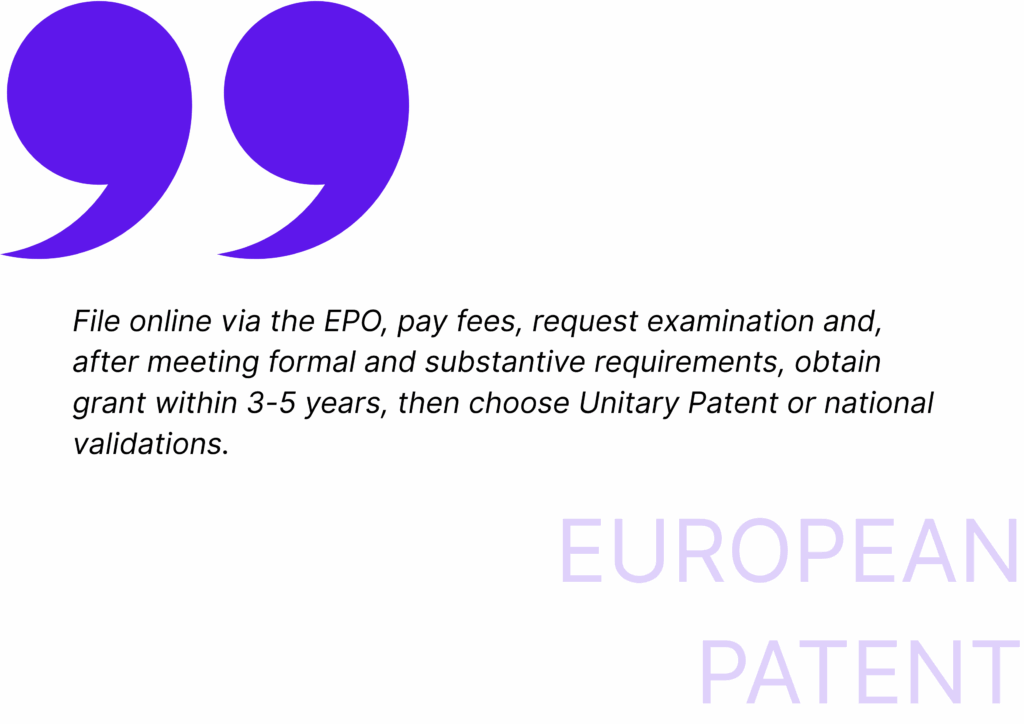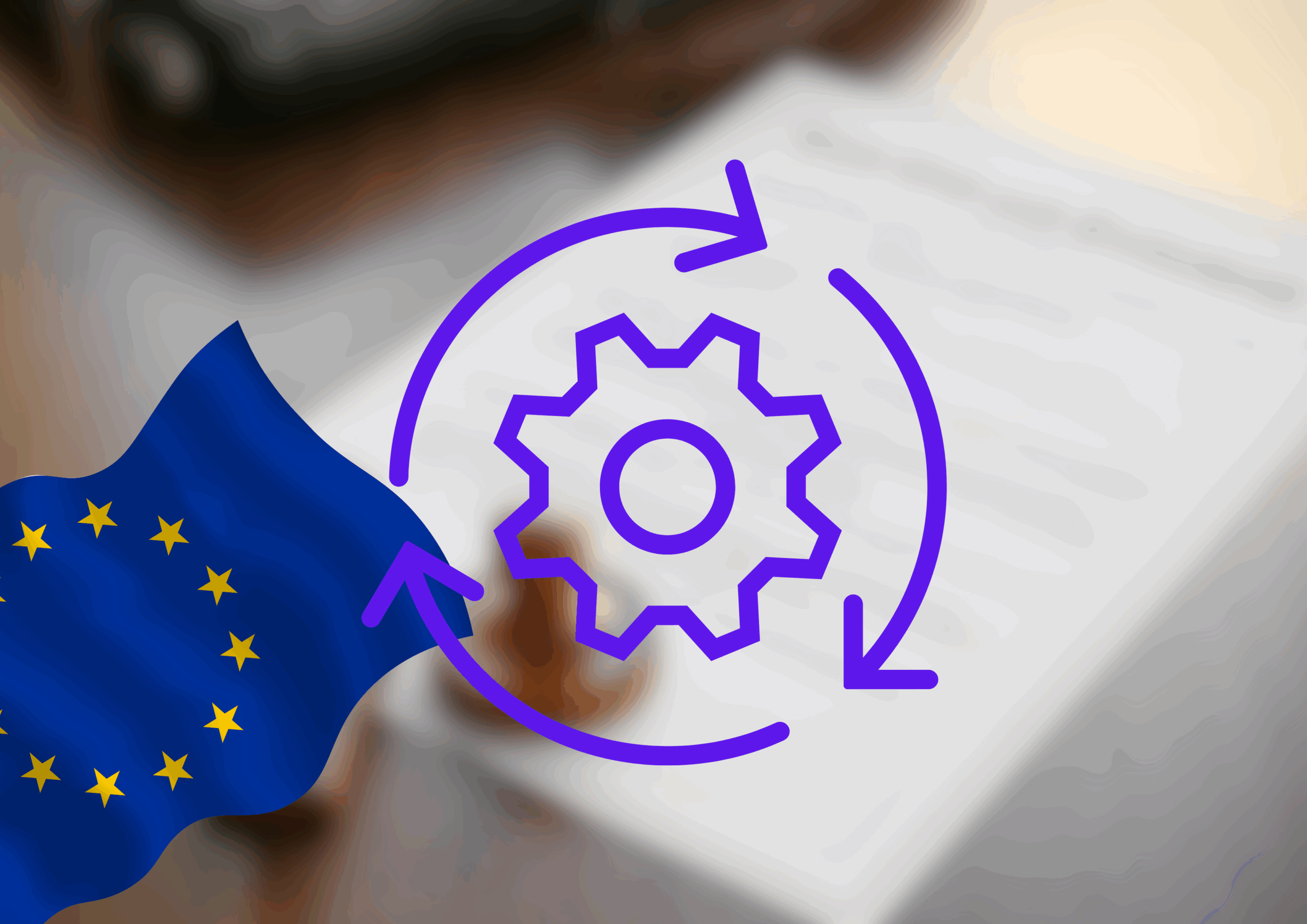Table of Contents
File online via the EPO, pay fees, request examination and, after meeting formal and substantive requirements, obtain grant within 3-5 years, then choose Unitary Patent or national validations.
Mapping the journey from idea to grant
However, many founders assume the European Patent Office (EPO) operates like a faceless bureaucracy. In reality it behaves more like a digital service centre with fixed checkpoints and automatic reminders.
Additionally, the European patent application process formally begins once the EPO receives a description of the invention and an indication that claims will follow. The filing date is secured as long as these elements and the applicant’s details are provided, although claims and drawings may be filed later . Following a short formalities check, the Office issues a filing receipt and your European patent number—often within 48 hours—so you can truthfully label marketing material “patent pending”. That early intangible asset reassures investors that due diligence is under way.
Filing routes and languages
In short, applicants may file directly with the EPO, enter the European phase of an international PCT application or claim priority from an earlier national filing. Each route converges on the same electronic dossier once it reaches Munich, but only direct or PCT-regional filings qualify for the 30 % online filing fee discount . Language choice is flexible: any EU language at filing is accepted provided a translation into English, French or German follows within two months, with EUR 500 translation compensation for eligible SMEs under the Unitary Patent scheme .
Furthermore, a proactive claim-drafting strategy can shorten examination. EPO examiners object when claims cover more than one invention or lack clarity; tightening scope early prevents iterative objections later. Several venture-backed startups report saving nearly a year of total prosecution time by investing in an extra prior-art search before filing, an expense that pays for itself by reducing attorney correspondence cycles.

Examination choreography
Notably, once the European search report issues, the EPO attaches a written opinion on patentability. This early feedback allows teams to pivot claim strategy before formal examination begins, saving both time and argument. Applicants then have six months to request examination; missing that deadline irrevocably withdraws the application.
Crucially, examination is a dialogue. Expect one to two office actions on average. Clear, concise responses that target each objection are rewarded with swifter allowance, whereas generic rebuttals often trigger protracted rounds.
Timelines, costs and speed hacks
Meanwhile, founders must juggle burn rate against patent milestones and cash calls. Official fees are public and predictable, yet many teams still budget by rumour. Why risk unpleasant surprises when the full schedule is on the EPO website?
Precisely, many fees can be deferred until your concept shows market traction. For example, you can file with basic claims and drawings, pay only the filing and search fees upfront and decide on examination after the search report reveals the prior-art landscape. This staged spending lets lean startups manage cash without sacrificing priority dates.
- Filing fee: EUR 2 000 when filed online (2025 schedule)
- Search fee: EUR 1 845, payable within six months, often bundled at filing.
- Examination fee: EUR 1 705, due on request within six months of the search report
- Designation fee: now zero for all EPC states, removing an old budgeting headache.
- Renewal fees pre-grant: none until year 3, then EUR 525 escalating annually until grant.
Equally, founders can trim months by responding to examiner communications within two weeks instead of the permitted four, signalling seriousness to the Office and often prompting the examiner’s next action sooner.
Consequently, the headline budget to reach grant usually lands between EUR 6 000 and EUR 8 000 in official fees—well under the cost of a single mid-level engineer’s salary for a month. Smart CFOs therefore ring-fence an IP budget at seed stage rather than scrambling post-Series A. Ideas spark progress.
Ultimately, smart founders treat prosecution metrics as KPIs. A dashboard in the MyEPO Portfolio portal shows statutory deadlines, fee status and examiner correspondence in one place, turning IP from a legal silo into an agile sprint board .
For instance, opting for the Unitary Patent after grant is like catching one flight that lands in seventeen EU capitals simultaneously instead of booking seventeen separate tickets. The single renewal schedule and central enforcement at the Unified Patent Court can slice maintenance costs by up to 35 % over twenty years .
Finally, if speed is critical, lodge a PACE request or use the Early Certainty programme: both prioritise your file without extra fees and can compress total pendency to under two years .
Treat the patent timeline as a Gantt chart—deadlines are immovable, but many tasks can be front-loaded to finish earlier than competitors expect.
How long does the EPO take to issue the search report?
The commitment is six months from the filing date (or European phase entry) for most technologies, barring workload fluctuations.
Can I rely only on a Unitary Patent and skip individual national validations?
Yes. If your patent is granted on or after 1 June 2023 and you file the Unitary Patent request within one month of grant, coverage automatically spans the participating EU states.
What if I need protection before grant?
File early, mark materials “EP patent pending”, and use confidentiality agreements. You may also request provisional injunctive relief in some UPC member states under trade-secret law.



